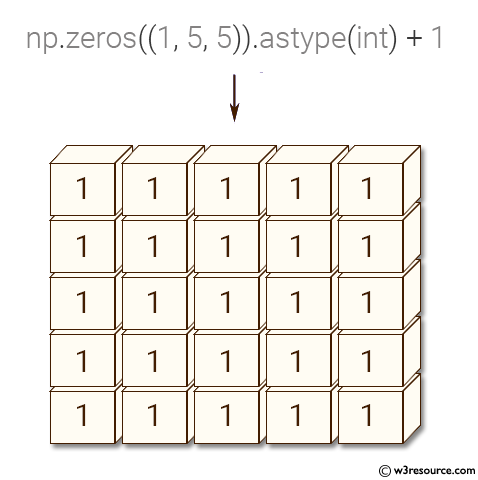NumPy: Create a 5x5x5 cube of 1's
Create 5x5x5 Cube of 1’s
Write a NumPy program to create a 5x5x5 cube of 1's.
Pictorial Presentation:

Sample Solution:
Python Code:
# Importing the NumPy library and aliasing it as 'np'
import numpy as np
# Creating a 3-dimensional array filled with zeros of size 5x5x5 and converting it to integers
# Adding 1 to each element of the array using the 'astype' method
x = np.zeros((5, 5, 5)).astype(int) + 1
# Printing the resulting array 'x' filled with the value 1
print(x)
Sample Output:
[[[1 1 1 1 1]
[1 1 1 1 1]
[1 1 1 1 1]
[1 1 1 1 1]
[1 1 1 1 1]]
[[1 1 1 1 1]
[1 1 1 1 1]
[1 1 1 1 1]
[1 1 1 1 1]
[1 1 1 1 1]]
[[1 1 1 1 1]
[1 1 1 1 1]
[1 1 1 1 1]
[1 1 1 1 1]
[1 1 1 1 1]]
[[1 1 1 1 1]
[1 1 1 1 1]
[1 1 1 1 1]
[1 1 1 1 1]
[1 1 1 1 1]]
[[1 1 1 1 1]
[1 1 1 1 1]
[1 1 1 1 1]
[1 1 1 1 1]
[1 1 1 1 1]]]
Explanation:
The above code creates a 5x5x5 NumPy array filled with ones (integer data type).
np.zeros((5, 5, 5)): This function call creates a 3D NumPy array with dimensions 5x5x5, filled with zeros. By default, the elements are of float data type.
.astype(int): This method converts the data type of the elements in the array from float to integer.
+ 1: This operation adds 1 to each element in the integer array. Since the array was initially filled with zeros, adding 1 to each element results in an array filled with ones.
Finally print(x) function prints the 5x5x5 integer array filled with ones.
For more Practice: Solve these Related Problems:
- Write a NumPy program to generate a 5x5x5 array filled entirely with ones using np.ones.
- Create a function that builds an n-dimensional cube of ones and verifies its shape and content.
- Generate a 3D cube of ones and then replace a central sub-cube with zeros to test advanced indexing.
- Compare the output of np.ones with a manual repetition of a scalar value to form a 5x5x5 array.
Go to:
PREV : Display Array Elements in Fortran Order
NEXT : Multiply Array (3,4) Elements by 3
Python-Numpy Code Editor:
Have another way to solve this solution? Contribute your code (and comments) through Disqus.What is the difficulty level of this exercise?
Test your Programming skills with w3resource's quiz.
